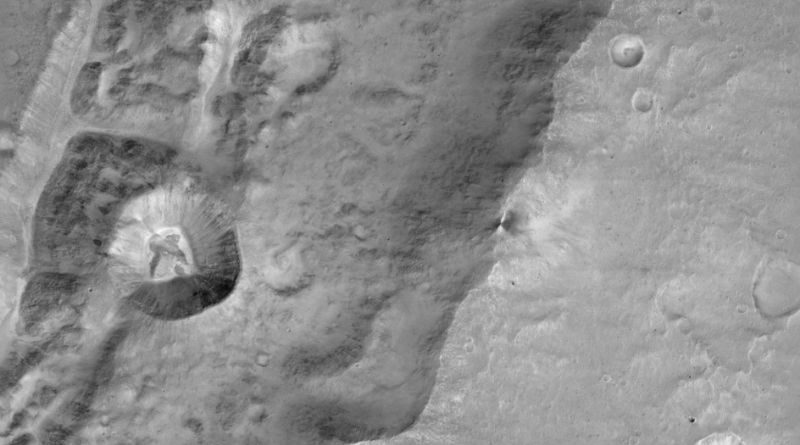ESA’s Trace Gas Orbiter delivers first Science Data from Mars ahead of Orbit-Lowering Campaign
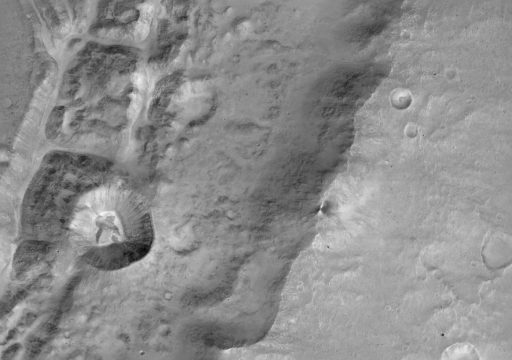
The European Space Agency’s Trace Gas Orbiter successfully completed a pair of science checkout orbits around Mars and delivered a first glimpse of the scientific results to be expected from the orbiter’s instrument suite once reaching a low orbit around the planet in late 2017.
The Trace Gas Orbiter (TGO) is the principal component of the ExoMars 2016 mission, launching atop a Russian Proton-M rocket on March 14 and dispatching the Schiaparelli lander onto an intercept trajectory with the Martian Atmosphere on October 16 followed by a critical two-and-a-half-hour engine burn on the 19th of October to be captured in a highly elongated orbit around Mars. TGO’s mission objectives are twofold – employing four instruments to study the composition of the Martian atmosphere, also with respect to the planet’s habitability, and acting as an orbital relay point for the transfer of data from rovers on the surface of Mars to receiving stations on Earth.
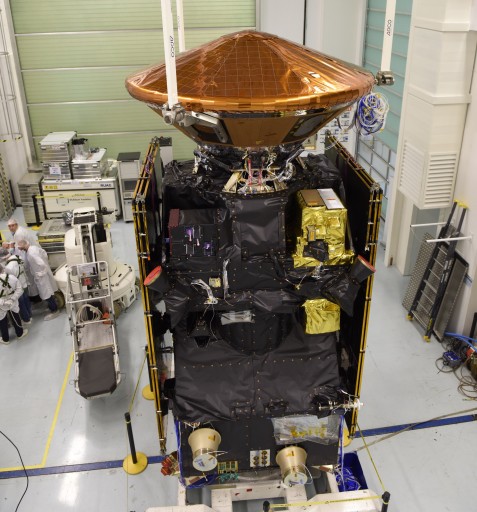
At present, the Trace Gas Orbiter is in a highly elliptical orbit around Mars with a high point at 98,000 Kilometers and a low point between 230 and 310 Kilometers – permitting science measurements to be collected when the spacecraft is in close proximity to the planet.
Having passed health checks after the critical orbital insertion maneuver, TGO was cleared to re-activate its instruments and operate them for a pair of orbits between November 20 and 28, each lap around the planet taking 4.2 days.
TGO is outfitted with four science instruments – a pair of spectrometers to identify atmospheric species down to extreme trace amounts, a color & stereo camera to obtain imagery of potential sources & sinks of atmospheric trace gases, and finally a radiation monitor to measure the radiation dose encountered on the transfer to Mars & in orbit while also studying water deposits in the sub-surface.
Over the course of its mission, TGO will be tasked with taking a detailed inventory of trace gases in the Martian atmosphere, making up less than 1% of the atmospheric volume. These include water vapor, nitrogen dioxide, ozone, acetylene and methane which has been a focus of scientific study for the past years as findings suggest methane can temporarily occur in the Martian atmosphere.
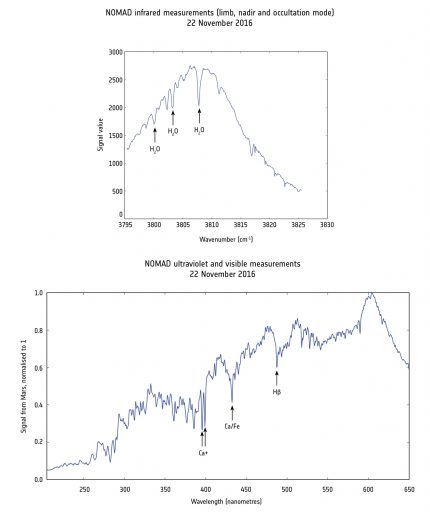
NOMAD (Nadir and Occultation for Mars Discovery) was tasked with a number of observations during its first checkout orbit including a series of dark and solar calibration measurements as well as measurements around the close passage of Mars, taking data on the day and night side of the planet as well as the illuminated limb. All three channels of the instrument functioned as expected and spectral data was collected in the ultraviolet, visible and infrared bands.
The NOMAD project released an infrared spectrum obtained by the Limb, Nadir and Occultation channel showing prominent absorption lines of atmospheric water while a spectrum from the Ultraviolet & Visible Channel shows the solar spectrum and absorption lines caused by atmospheric species. These measurements show NOMAD is operational and ready to tackle its main task of studying the Martian atmosphere and its composition down to extreme trace levels of a few parts per billion, measured with an unprecedented accuracy.
The other spectrometer, the Atmospheric Chemistry Suite (ACS), was also in action during the first of the two science orbits, employing three different spectrometers to capture data across the infrared spectrum which will permit the instrument to detect and quantify a variety of atmospheric species including suspended aerosols and isotope ratios for different elements. ACS used the first orbit to collect calibration data looking at Carbon Dioxide, the most abundant compound in the Martian atmosphere. ACS data also shows signatures of silicate dust in the atmosphere and measured the Martian surface temperature around noon, reading right around 0° Celsius.
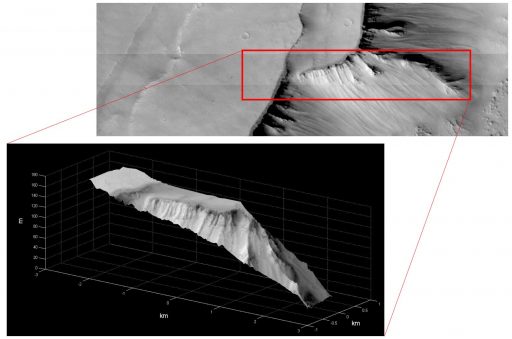
TGO’s camera, known as CaSSIS – Color and Stereo Surface Imaging System, collected 11 images during the first close flyby of Mars on November 22. Closest approach occurred at an altitude of 235 Kilometers over Hebes Chasma, north of Valles Marineris, enabling CaSSIS to capture imagery at a resolution of 2.8 meters per pixel. These are the sharpest images collected during the TGO mission since the operational orbit of the mission will not allow the spacecraft to come this close to Mars.
CaSSIS demonstrated both its full-color imaging capability and stereo-imaging feature, requiring the instrument to be physically rotated to collect a pair of images of the same location from different look angles. The 3D reconstruction of a region in Noctis Labyrinthus offers an impressive look at what the instrument will be able to do once in operational service, both in terms of three-dimensional accuracy and image resolution.
Even though the first images collected by CaSSIS are impressively sharp, the instrument team identified some improvements to be made in the onboard software and image post-processing on the ground. Performing science checkout orbits before the lengthy orbit-adjustment campaign gives teams plenty of time to make the necessary modifications to the instruments to ensure all can collect the best possible data once TGO is declared ready for science.
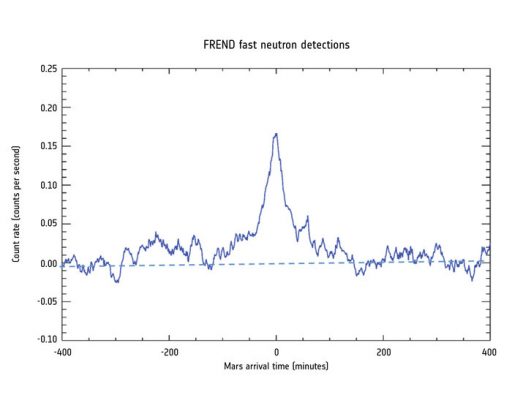
TGO’s radiation-sensing instrument known as FREND (Fine Resolution Epithermal Neutron Detector) was also able to collect its first data in orbit around Mars. FREND hosts two instrument modules, one to measure neutrons coming from the Martian surface and the other to assess the flux, absorbed dose and dose intensity from cosmic rays which is of relevance for future crewed flights to Mars.
FREND was active for most of the cruise to Mars to measure the deep space radiation environment before being powered down on September 15 in preparation for the critical orbital insertion. The instrument was re-activated on October 31st and held several sessions of measurements during the periapsis passes to exercise the collimated part of the instrument that will be tasked with measuring the energy of neutrons emitted by the Martian surface as the result of Cosmic Ray impacts. The energy of the arriving neutrons can reveal the composition of the surface layer with particular focus of water or ice deposits just below the surface.
Initial data from FREND shows the instrument is functioning well and can measure relative differences between regions of high and low neutron flux and also detect an overall decline in neutrons when the spacecraft moves further away from Mars. FREND will need several months of measurements from TGO’s operational orbit to deliver statistically significant results that can help scientists peer below the Martian surface on a global scale.
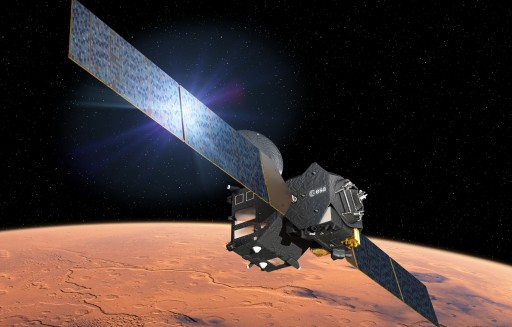
Having delivered a preview of what’s to come during the operational mission, TGO is now set for a long transfer into its operational orbit. Still in an elliptical orbit, TGO will fire up its main engine in January to complete a plane change into a 74-degree orbit optimized for the science and radio relay mission. The maneuver will also shorten the orbital period from four Martian days to a 1-day orbit.
Next will be a lengthy aerobraking campaign – slightly lowering the low point of TGO’s orbit to skim the outermost layers of the Martian atmosphere to employ the solar arrays as ‘drag brakes’ to progressively slow the spacecraft with each close brush past Mars and so bring down the high point of the orbit to the desired 400-Kilometer altitude. Aerobraking is a lengthy process but has the advantage of only requiring very little fuel for setting the correct periapsis altitudes.
TGO is planned to arrive in its circular science orbit in November 2017 and begin regular science data collection one month later to kick off a five-year primary mission – long enough to study atmospheric changes over extended time scales and tie phenomena seen in the atmosphere to external influences or surface activity.

